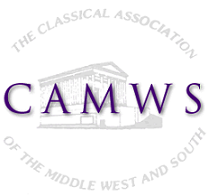2017 Semple Award Winner Molly Harris
 With the generous support of the Semple Award from CAMWS, this past summer I participated in the Summer Session of the American School of Classical Studies at Athens (ASCSA). For six weeks, our group of twenty students traveled across Greece, visiting sites and museums and learning about the history and culture of the region from ancient times to the present. I cannot imagine a better first visit to a country I had only yet studied from a distance!
With the generous support of the Semple Award from CAMWS, this past summer I participated in the Summer Session of the American School of Classical Studies at Athens (ASCSA). For six weeks, our group of twenty students traveled across Greece, visiting sites and museums and learning about the history and culture of the region from ancient times to the present. I cannot imagine a better first visit to a country I had only yet studied from a distance!
Each and every day was packed with museum tours and excursions to archaeological sites. Within the first week, we had already gained exclusive access to the porch of the Parthenon, toured the Agora with the Director of Excavations, and gazed upon the face of "Agamemnon" at the National Archaeological Museum of Athens. Though the school is based in Athens, we also spent plenty of time on the road-a week traversing the island Crete, ten days hopping across the Peloponnese, and a week throughout northern Greece. Experts guided us through the nooks and crannies of every site. Each scholar gave insight into current research and provided his or her own perspective on Greek history and culture. In turn, we participants presented our own research at various sites, mine being the Temple of Asclepius and Tholos at Epidaurus and the Temple of Apollo and Oracle at Delphi. The school's Blegen Library offered extensive resources and working space for us to prepare our reports.
The Summer Session gave me exposure to the fascinating variety of methodologies used in Classics research. We were given a behind-the-scenes look at the technologies employed by archaeologists - from detailed excavation notebooks to new apps that map sites and catalogue finds. The scientists at the American School's Wiener Laboratory shared their work studying human, animal, and agricultural remains from as far back as the Neolithic period, and we saw in action the scanning electron microscope that can magnify to 300,000 times actual size. At the Piraeus we learned about the unique challenges that come with underwater archaeology, and at Knossos we discovered how the accepted processes for reconstructing art and architecture from limited remains have changed over the last 100 years. On one of my favorite trips, a day-trip to northern Attica, we came to understand the human and environmental costs of the Athenian silver-mining process, costs that perhaps aren't addressed often enough in discussions of the Athenian empire.
The ASCSA encourages students to consider Greek culture from the ancient world all the way to the present day. During our six weeks, we studied the ancient Greeks, explored sites from the Venetian and Ottoman periods, visited monuments commemorating the Greek War of Independence, and learned about the role of Greece during the World Wars of the 20th century. I felt a personal connection to the Jewish sites we visited, such as the Etz Hayyim Synagogue in Chania, Crete. Here we traced the history of the Jewish community in Crete from the Hellenistic period through the rededication of the synagogue some fifty years after the devastation of WWII. Of course, when we weren't visiting sites, we were experiencing modern Greece. We learned how to spin komboloi beads from our bus driver Spiros, went swimming in the sea to take a break from the hot Mediterranean sun, watched a performance of the Athens State Orchestra, and regularly enjoyed delicious Greek salads and chicken pitas.
The Summer Session wouldn't have been complete without the people: the fabulous staff at Loring Hall, the current members of the American School, our session director Dr. Ann Nicgorski, and my fellow participants, who came from a variety of academic and professional backgrounds. At ouzo hours and teas at the school, we shared what brought us to Classics and how we each are advancing the field in Greece, the United States, and across the world.
Although I'm no longer in Greece, my experiences from my summer there will continue to enrich my research and teaching. As I pursue research on Greek tragedy, I will recall watching a performance of the Bacchae at Epidaurus and sitting in the Theater of Dionysus at Athens. The memorials to the war dead at the Epigraphical Museum and the many images of battle we saw on museum artifacts throughout our travels will inform my future investigations into portrayals of war and homecoming. Finally, I have already brought my summer travels into the classroom. When my students read the Homeric Hymns to Demeter and Apollo, I shared my own photographs of Eleusis and Delphi and could now provide the latest research into the rituals that happened there.
My ASCSA summer is a pillar that will continue to support my future Classics research and teaching. I am grateful to CAMWS for its role in making this opportunity a reality.
Molly Harris
University of Wisconsin-Madison
